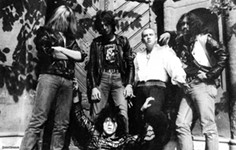Allan Rising
Out of the ashes of Allan Elementary comes the Allan Center
By Richard Whittaker, Fri., Feb. 5, 2016
Sometimes, education politics is about making lemonade out of lemons. When the Austin Independent School District handed the beloved but under-enrolled Allan Elementary over to a charter school group in 2012, the East Austin community was left with a bitter taste in its mouth. When the district reclaimed the campus a year later, but left it empty, the bitterness remained. But now the old Allan campus has found new life as the Allan Early Childhood Center, a home for nonprofits that the district hopes won't just fill a building, but help restore and bolster the community.
If you visited the Allan campus in January of this year, you'd never know that this wasn't still a working school. Some of the classrooms were full of elementary students again, but it wasn't a permanent deal. After Palm Elementary was flooded out over Halloween, the youngest students were transferred to Allan while their classrooms were rebuilt and cleared of mold. That's one inadvertent advantage to the district having the campus at least partially empty. AISD Chief Schools Officer Edmund Oropez said, "One of the things that we'd created here was a swing-space, just in case."
But there's a lot more going on here than some spare space in case the rains come. The former campus is packed with a diverse array of nonprofits. The biggest footprint is taken by Avance Austin which, along with health and social services charity Child, Inc., was part of the first wave of new tenants.
"A Godsend in So Many Ways"
Avance has been a longtime partner with AISD, providing a dual-generation parenting education/early childhood service, combining campus assistance with home visits, serving parents with kids aged 3 and under, which Executive Director Marie Felan described as "the most important time for brain development and growth." Felan explained the group's goal as "to really strengthen and support a parent's ability to be the first teacher in their home." Before the move to Allan, providing that service was a challenge: With no permanent space on any campus, the group was effectively providing services to six schools out of the back of a truck, all the while paying commercial rental prices for their offices. "We were a pop-up shop," said Felan. "Packing everything up in a van, unpacking it, packing it back the next day, coming back to the headquarters six days a week."
Now they occupy roughly a tenth of the campus, and rather than paying $16.50 per square foot in rent alone for their old office, the nonprofit pays about $7 per square foot in utility costs to the district. They operate in several former classrooms in the eastern wing of the building. One room has been split in two, with cribs and changing facilities for babies on one side, and mats for toddlers on the other. Another is a combination office- and toy-supplies storage room, with bright strands of wool popping out of filing cabinets.
Felan described moving to a permanent facility at Allan as "a godsend in so many ways," not least of which is their outreach. Back when they were in the truck, her staff were helping roughly 150 parents and students at a time. Having a permanent facility means they are reaching double that number: They're still using vans, but now they're bringing their clients from the neighborhood to Allan.
Avance is just one of the nonprofits invited to Allan by AISD's longstanding community outreach partners Austin Voices in Education and Youth, which selected a diverse group of applicants to reflect the campus' new role as an early childhood education and STEM (science, technology, engineering, and math) center. Alongside the groups helping kids directly, there are adult education organizations like the Literacy Coalition of Central Texas and Skillpoint Alliance, and environmental groups like EcoRise Youth Innovations and Urban Roots. Walking the halls, Austin Voices Executive Director Allen Weeks stops in front of the most recent tenants, Austin Youth River Watch, whose volunteers he had recently seen cleaning out the creek near his house. They're one of the groups on campus that could add another E to STEM – ecology. Weeks said, "There's a beautiful space here, and potential for gardening that would serve the community."
Community is the heart of everything here, with the center as an expression of the new community schools movement. Unlike the self-proclaimed education reform movement, which seems hell-bent on running education on corporate metrics, community schooling is based around bringing resources and social programs to bolster public schools and the entire neighborhood. "It's about lowering barriers to success," said Weeks. "Avance is lowering barriers to success for these kids by giving them that early start and giving their parents those right early start experiences. Skillpoint is lowering those barriers for adults who otherwise may not be ready to attend [Austin Community College], but if they could have one introductory step, then they'd be ready."
Gabriel Estrada, Austin Voices' youth and community facilitator, is already finding a lot of excitement in the community now that Allan is back. "You have a lot of alumni in the neighborhood who are saying the Bulldogs are back. It starts radiating throughout the neighborhoods, and they key in on that, and they look for the idea that, oh, it's open again. But they're also learning. It's not my junior high anymore, it's not the elementary anymore, so what is it? And then they start to learn more."
Making Lemons Out of Lemonade
Although no longer a school, the new Allan Center is quietly busy. It's a big change from just a couple of years ago, when it was an empty space, left vacant after one of the worst examples of community engagement in AISD's history. In 2011, trustees voted to embark on a grand experiment: hand the campus over to IDEA Public Schools, a charter group out of the Rio Grande Valley, to turn the campus around. The only problem was the school was classified as academically acceptable by the Texas Education Agency, so didn't exactly need saving. The experiment lasted one contentious year, with families pitted against IDEA and the district, until trustees canceled the contract. And then they were left with an empty building.
After the disastrous imposition of IDEA, the district changed tack completely. Instead of imposing centrally designed strategies, the administration used Austin Voices to ask the community what it wanted. At every stage, outreach, consultation, and communication has been the first order of business, starting with a community movie night to explain to people that, yes, Allan was back. Chief Schools Officer Oropez said, "It was just bringing in the families to tour the facilities. Not just families, but all community members and business leaders, and announcing the presence of what this space is going to become, and what the vision is for it."
At the moment, the emphasis is on early childhood and STEM, but Weeks described the long-term goal of Allan being "an early childhood but also an adult training center. That's a new problem, to have adults and children in the same building as learners." That's meant a logistical learning curve, working on simple issues like security and access, as well as de-mothballing what's left of the building, but Weeks described it as well worth the investment. "Just having Avance and Literacy Coalition in the same building, good things will happen," he said. "The vision is that parents would come here for a parenting class and say, 'Ah, there's a Skillpoint Alliance class, there's a nursing class, I'd like to take that,' and eventually it becomes a real vibrant hub."
AISD hasn't just handed the keys over to the charity. The campus is also the home to a panoply of district staff: Parent support specialists, behavioral specialists, nursing, pre-school programs for children with disabilities, and media services all call Allan home. But their purpose is basically the same as the charities' – to create the support system and environment where kids can learn. Weeks said, "Every day, this space is full of community folks, taking advantage of the programs."
However, there's an elephant in the room. Allan was an elementary before it was handed over to IDEA, and IDEA ran it as an elementary. So why isn't it still an elementary?
The key is to not think about Allan as a school, but as an AISD facility. After all, it was originally founded in 1957 as Allan Junior High, because the neighborhood needed and could sustain a junior high. In 1980, it became an elementary, because the neighborhood needed and could sustain an elementary. Now the brutal truth is that the neighborhood may want an elementary, and the families still need an elementary, but the numbers just aren't there. However, that same community needs social services.
When the AISD board invited in IDEA, supporters sold it as a way to curtail declining enrollment. This wasn't just an Allan issue, but an endemic problem for campuses in the area. Looking at the four elementaries servicing Central East Austin – Allan, Brooke, Govalle, and Ortega – all saw dramatic decreases in student numbers, from a combined high of 1,871 in 1999 to a new low of 1,078 this year. IDEA Allan saw numbers rise a little, but only by aggressively recruiting districtwide, raising the question of whether they were running a neighborhood school or a magnet. Even with Allan closing, only Govalle saw a real boost, and that's fading. Meanwhile Brooke is not only under-capacity, but around 200 of its 266 students actually live in the nearby Linder attendance zone. Trustee Jayme Mathias, whose district includes Allan, Brooke, and Govalle, said, "That tells us that that neighborhood is no longer able to sustain an elementary school. What do we do about that?"
Closing any campus is supposed to be antithetical to AISD's principles. In 2011, stakeholders revolted against a facility master plan that had proposed closing or mothballing under-enrolled elementaries. At the time, that policy reversal was seen as a statement of moral intent, that neighborhoods needed neighborhood schools. Yet Allan is an Austin neighborhood stripped of that same core. It felt like a cruel joke; the ultimate defeat.
The political backlash against the IDEA deal was one of the most significant watersheds in AISD history. In the following 2012 election, voters effectively purged all traces of the trustees who had voted for the IDEA handover – a clear sign that Austin voters would not tolerate the education reform agenda promoted by then-Superintendent Meria Carstarphen. Her position also became untenable, and within a year she had departed for Atlanta, replaced by former Chief Schools Officer Paul Cruz.
"A String of Victories"
As spokesman and lead organizer of PRIDE of the Eastside, Vincent Tovar was one of the key players in that community opposition, and he saw both the struggle and the fallout. He stood out in the rain to protest the board's decision; as a parent to students at Govalle, he was there to welcome Allan families when his neighborhood campus absorbed its share of this local diaspora; and then he helped organize to oust IDEA backers from the board. Ugly as the whole incident was, Tovar looks back on it now as "a string of victories." The community lost an elementary, but they flipped the school board, leading to Carstarphen's ouster, and sent a clear message to charters that they weren't wanted in AISD. He said, "It felt like we controlled our destiny. We took the decisions that were so often made for us, and we made them for ourselves."
Tovar became known as one of the district's foremost critics, but now he's helping shape the future of the new Allan. He was part of the original community outreach committee that shaped the new vision, and takes partial credit for including the early childhood provision. After years of clashing with the direction AISD had taken with Allan, now he calls it "an incredible hub for education that is urgently needed in our community."
Moreover, this is just phase one of plans for the Allan Center. The hope for phase two, with the rollout of more STEM and adult education opportunities, is that the synergy between the different nonprofits could provide unique opportunities for the community. A parent who brings their baby to Avance could see career and skills training possibilities in the services that Community Advancement Network offers. Conversely, Felan said, Avance might start using its sleep and play areas as a crèche for parents wanting to use the facilities. She also described being on a campus as a way to introduce some parents – particularly migrant families that may never have experienced U.S.-style education – to how a school operates, demystifying the whole process. Felan said, "It emulates what's going to happen when their child enters pre-K or Early Head Start."
Allan's non-academic provisions could also be a way to raise enrollment at Brooke, Govalle, Ortega, and beyond. A kid who gets involved in the new STEM center could find the encouragement they need to stay in the STEM-centric Eastside Memorial Vertical Team, rather than transfer out of the area. Half-joking, Weeks has suggested turning the old gym into a robot arena, but with robotics playing an increasing role in STEM, that could become a real possibility. Similarly, the library currently sits empty, and there have been proposals to turn that space into a maker space, a toy library, a community library, or all of the above. Even the old cafeteria has found new life, as a community meeting and event facility. After all that exposure, the district could engender a new level of trust and loyalty with families, who might think twice about abandoning their neighborhood schools for the siren lure of a charter operation. All the while, Austin Voices and its community partners are receiving more and more applications from nonprofits, and finding more and more partners with whom to work. Weeks said, "You're going to look at this two years from now, and see an amazing scope of programming coming out of this building."
And then there's the broad draft idea for phase three. There are serious discussions that could see AISD taking a radical step from simply serving and supporting a low-income community to actually housing it, and getting into the landlord business.
It all boils down to Allan being a prime piece of real estate in the middle of a hot housing market. The short game would be to sell it off to developers, and hope that there's an affordable housing component in there somewhere. But what's being proposed by advocates such as Tovar, and seriously considered by board members such as Mathias, is a much longer game. If AISD took some of that space, and partnered with developers to turn it into affordable housing themselves, they could bring in the families to help boost student enrollment.
This isn't an East Austin problem, but an Austin problem. The AISD board has started discussions about what to do with underutilized facilities across the district, and the idea of getting into the affordable housing business has come up in those talks. Mathias said, "Roughly 10 percent of the housing stock in Austin is affordable for families that make 75 percent of the median family income. The message is that, if you make less than $57,000, and you need a family home, there's nowhere for you in Austin." He even suggested the district could start providing housing for one particular group that's being forced out of the neighborhood by rising prices – its own teachers. Mathias said, "How many of our teachers are making $57,000?"
Of course, behind all this is the specter of gentrification, and Tovar has been a consistent critic of the rising prices that push poorer working families out of East Austin. Yet he's also realistic that, if the community is changing, the district can't just hope that some social programs or a few affordable housing units will turn that tide. Instead, AISD has to find ways to encourage the new families moving in to pick neighborhood campuses like Govalle. He said, "You have your space, you have your family, you don't send your kids to Govalle. Why? 'Because it's not the right school for my kid.' Why isn't it the right school for your kid? 'Oh, because they don't offer the right programs.' What programs do you want?"
And maybe, just maybe, Allan could help by bridging the gap between the old and new communities. Recently, Felan said, a couple of residents of the neighborhood were jogging past, and started asking about volunteer opportunities with nonprofits at the center. It may not be the old Allan community, but if Felan's right, it could be the first signs of a new one.
Austin ISD Elementary Enrollment in Central East Austin

Got something to say on the subject? Send a letter to the editor.















